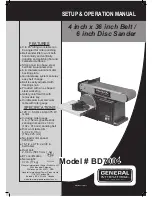
English
7
150311
13.
PLACE THE SANDER
so neither the operator nor the bystanders is forced to stand in line with
the abrasive belt or disc.
14.
TO AVOID INjURY DUE TO UNExPECTED SANDER MOVEMENT:
•
always unplug the sander before moving it.
• Put the sander on a firm, level surface where there is plenty of room
for handling and properly supporting the workpiece.
•
support the sander so it does not rock.
•
attach the sander to its work surface, use the fasteners and method
shown
15.
NEVER STAND ON THE TOOL.
serious injury could occur if the tool tips. Do not store anything above
or near the tool where anyone might stand on the tool to reach them.
16.
OBTAIN ADVICE
from your supervisor, instructor or another qualified person if you are
not thoroughly familiar with the operation of this machine. Knowledge
is safety.
17.
NEVER TURN THE MACHINE ON BEFORE
clearing the table/work area of all objects (tools, scraps of wood, etc.).
Flying debris is dangerous.
18.
NEVER TURN THE MACHINE ON WITH THE WORkPIECE
CONTACTINg THE ABRASIVE SURFACE.
Kickback can occur.
19.
SECURE THE MACHINE TO A SUPPORTINg SURFACE.
Vibration can cause the machine to slide, walk or tip over.
20.
USE A DUST COLLECTION SYSTEM.
some types of wood dust are known to cause disease or other health
problems.
21.
CLEAN THE MACHINE AND DUST COLLECTOR
thoroughly when processing different types of materials (wood, steel or
aluminum). combining wood and metal dust can create an explosion
or fire hazard. DO NOT SAND OR POLISH MAGNESIUM. Fire will
result.
CAUTION!
This machine is not designed for heavy de-burring
operations. When finishing metals, sparks or hot fragments could cause
a fire. To avoid this:
Disconnect any dust collecting hose from the sander.
Remove all traces of wood dust from inside the sander.
Remove all traces of metal dust from inside the sander before sanding
wood again.
22.
PREVENT THE WORkPIECE FROM CONTACTINg THE SANDINg
SURFACE BEFORE STARTINg THE TOOL.
Loss of control of the workpiece is dangerous.
23.
MAINTAIN A MAxIMUM CLEARANCE OF 1/16 IN.
between the table or the back stop and the abrasive disc or belt. the
workpiece could be drawn into the space between the abrasive disc
or belt and the table. When checking clearance between the belt and
work support, press the belt flat against the metal beneath it.
24.
INSPECT YOUR WORkPIECE
Make sure there are no nails or foreign objects in the part of the
workpiece to be sanded.
25.
PLAN YOUR WORk TO AVOID kICkBACkS
when the workpiece catches on on the moving abrasive and is torn
from your hands.
26.
MAkE SURE THERE IS NO DEBRIS
between the workpiece and its supports.
27.
WHEN SANDINg IRREgULARLY-SHAPED WORkPIECES, PLAN
YOUR WORk SUPPORT
so it will not slip and be pulled from your hands.
28.
USE ExTRA CAUTION
with large, very small or awkward workpieces.
29.
NEVER USE THIS TOOL TO FINISH PIECES TOO SMALL TO HOLD
by hand.
Summary of Contents for BD7004
Page 23: ...English 23 150311 Schematic Drawing...
Page 24: ...English 24...
Page 47: ...FRan ais 47 150311 Schema...
Page 48: ...Fran ais 48...








































